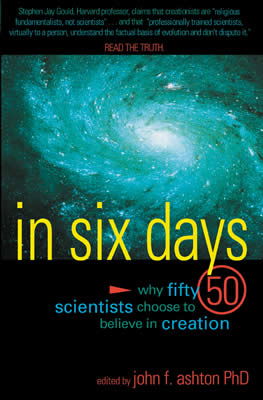
Chapter 14
Dwain L. Ford, Organic Chemistry
After examining both sides of this issue for 40 years, I submit the following reasons why I have retained my faith in God as the Creator.
is Emeritus Professor of Chemistry, Andrews University, Berrien Springs, Michigan. He holds a B.A. in chemistry from Andrews University and a Ph.D. in chemistry from Clark University, Worcester, Massachusetts. Over an academic career spanning more than 30 years at Andrews University, Professor Ford served in various positions including chairman of the Department of Chemistry and dean of the College of Arts and Sciences. He was the recipient of five awards for excellence in teaching as well as three National Science Foundation fellowships.
As a boy growing up on a farm in Minnesota, I came to appreciate the Bible stories at home and at church. In spite of my mild case of dyslexia, I completed reading the entire Bible by about the time I graduated from elementary school. My faith in God was strengthened by numerous answered prayers.
When I entered graduate school in 1958 to work toward a Ph.D. in chemistry, my faith in Scripture was seriously challenged by my major professor. I wondered if it were possible that I had been wrong all my life and my professor right. He seemed very certain about his ideas and he wanted me to do research toward the development of his theory of biochemical evolution. Since I was skeptical of his theory, I was asked to witness each of the significant findings of another graduate student working on evolutionary research next to me in the lab.
As a scientist and a Christian, I have been forced to weigh the evidence available from both science and the Scriptures in an area in which experimental proof is impossible to achieve. After examining both sides of this issue for 40 years, I submit the following reasons why I have retained my faith in God as the Creator.
Chemical evolution...fails to adequately account for the origin of the proteins required for even the simplest known free-living organism.
Chemical evolution, based on random activity of molecules, fails to adequately account for the origin of the proteins required for even the simplest known free-living organism, Mycoplasma genitalium. This bacteria has one chromosome, a cell membrane, but lacks a cell wall and has the smallest genome of any known self-replicating organism. It has 470 genes, which contain an average of 1,040 nucleotide base pairs (bp). This implies that the average size protein coded for by these genes contains about 347 amino acids. The probability of forming, by a random assembly method, one such average-size protein molecule containing the amino acid residues in a required sequence is only 1/10451.
If the earth were made of pure carbon it would contain only about 1050 carbon atoms, but more than 10451 carbon atoms would be needed in order to make enough amino acids to form the proteins to achieve the probability of producing one protein molecule with the prescribed sequence. In other words, it would require an amount of carbon about 10401 times the size of the earth in order to achieve the probability of forming one required protein molecule with the specifications above! Realizing that the probability of producing proteins by a random assembly method is exceedingly small, some have proposed that DNA was formed by chemical evolution first and then it was used to direct the synthesis of the protein. This trades one problem for another. The random assembly of a gene containing 1,040 bp to code for a specified protein would be likely to require as much or more carbon than it would to make the protein directly by a random assembly method.
With a problem this great in forming one gene, imagine the problem of forming the 470 specific genes found in the one chromosome containing 580,070 bp: M. genitalium. Michael Behe, in his 1996 book Darwin’s Black Box, uses the term “irreducible complexity” to refer to such situations where all conditions must be met simultaneously in order for the organism to survive.
In spite of the excitement in the 1950s and early 1960s generated by research based on chemical evolution theory, the net result today is a clearer understanding of the magnitude of the problem of the origin of protein, DNA and life, without having found the answers. Since the only known method in nature for efficiently producing protein involves DNA, mRNA and tRNA interacting with proteins such as RNA polymerase, tRNA synthetases and ribosomal proteins, it seems reasonable to consider the possibility that all were formed simultaneously as part of intelligent design.
Even though there is general acceptance of the evidence for small genetic changes which may be referred to as microevolution, hard evidence for the formation of any new species by macroevolution is lacking.
Evidence for intelligent design is widespread in nature. For example:
-
The motorized rotating flagellum of some bacteria.
-
Blood clotting and its control.
-
The high degree of organization within a typical cell.
-
Cell division and its control.
-
The system for protein synthesis.
-
The human eye.
-
The respiratory chain based in the highly organized mitochondria.
-
The biosynthetic pathway in which acetyl CoA is the key compound.
Acetyl CoA is derived primarily from fatty acids and glucose and can also serve as an intermediate in the conversion of excess carbohydrate into fat. Oxidation of acetyl CoA in the citric acid cycle results, through the electron transport system, in the storage of energy in the form of ATP for chemical syntheses or muscular contraction. The acetyl CoA can also serve as the starting material for the synthesis of a wide variety of products, such as natural rubber, fragrance of lily of the valley flowers, oil of roses, menthol, oil of ginger, oil of celery, oil of cloves, carotenes, vitamins A, D, E and K, plus all the steroids, such as cholesterol, the female hormones progesterone and estradiol, the male hormone testosterone, etc. This is a small sample of the wide variety of natural products derived from acetyl CoA.
Why don’t we humans produce natural rubber in our bodies instead of about 50 kinds of steroids? The types of products, from this carefully regulated pathway, are determined by the specific enzymes in that species which are present at that time. The predominant products from this pathway may vary with time for a given species. The delicate balance that exists in this pathway can be illustrated by the fact that women make their female hormone estradiol from the male hormone testosterone, which they also produce. This does not cause a problem unless a woman develops adrenal cancer, which increases the amount of adrenal tissue capable of producing testosterone as well as other steroids. The first symptom usually observed by a woman with adrenal cancer is that she suddenly has to shave every day and her voice lowers in pitch, due to the production of testosterone faster than her body can convert it to estradiol. It seems very unlikely that an extremely complex pathway as this one, with all of its interconnecting processes and required enzymes, could arise purely by chance without an intelligent designer. I see no compelling arguments, based on chemical evolution or Darwinian evolution, which make it more reasonable for me to believe in evolution than in creation.
Just as scientific theories based on interpretation of data obtained by observation of the natural world are never absolutely proven, likewise I can never prove that the Genesis account of creation is true. I was not an eyewitness but, as a Christian I can, by faith, search for the testimony given by eyewitnesses. Who were those eyewitnesses of the creation events? God (Genesis 1:1), the Holy Spirit or Spirit of God (Genesis 1:2), Jesus Christ the Word (John 1:1–14).
The writers of the Bible were under the inspiration of God (eyewitness) as they wrote and they were moved by the Holy Spirit (eyewitness). God’s daily progress report during the Creation Week stated that “it was good” or “very good.” Christ (eyewitness), the Creator of all things, endorsed the Genesis creation report by quoting from it and chiding others for their ignorance of it. God wrote in stone that He had created in six days, and He is quoted twice in Exodus telling Moses to tell the Israelites that fact as well … and I believe Him.
In Six Days
Can any scientist with a Ph.D. believe in the idea of a literal six-day creation? In Six Days answers this provocative question with 50 informative essays by scientists who say “Yes!”
Read Online Buy BookRecommended Resources

Answers in Genesis is an apologetics ministry, dedicated to helping Christians defend their faith and proclaim the good news of Jesus Christ.
- Customer Service 800.778.3390
- Available Monday–Friday | 9 AM–5 PM ET
- © 2026 Answers in Genesis


